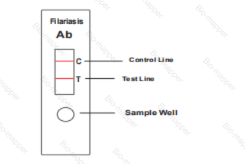SUMMARY AND EXPLANATION THE TEST
The lymphatic filariasis known as Elephantiasis, mainly caused by W. bancrofti and B. malayi, affects about 120 million people over 80 countries. The disease is transmitted to humans by the bites of infected mosquitoes within which the microflariae sucked from an infected human subject develops into third-stage larvae. Generally, repeated and prolonged exposure to infected larvae is required for establishment of human infection.
The definitive parasitologic diagnosis is the demonstration of microflariae in blood samples. However, this gold standard test is restricted by the requirement for nocturnal blood collection and lack of adequate sensitivity. Detection of circulating antigens is commercially available. Its usefulness is limited for W. bancrofti. In addition, microfilaremia and antigenemia develop from months to years after exposure.
Antibody detection provides an early means to detect filarial parasite infection. Presence of IgM to the parasite antigens suggest current infection, whereas, IgG corresponds to late stage of infection or past infection. Furthermore, identification of conserved antigens allows ‘pan-filaria’ test to be applicable. Utilization of recombinant proteins eliminates cross-reaction with individuals having other parasitic diseases.
The Filariasis Ab Rapid Test uses conserved recombinant antigens to simultaneously detect Antibody to the W. bancrofti and B. malayi parasites without the restriction on specimen collection.
PRINCIPLE
The Filariasis Ab Rapid Test is a lateral flow chromatographic immunoassay. The test cassette consists of: 1) a burgundy colored conjugate pad containing recombinant Filariasis specific antigen conjugated with colloid gold (Filariasis conjugates) and rabbit IgG-gold conjugates, 2) a nitrocellulose membrane strip containing a test band (T band) and a control band (C band). The T band is pre-coated with un-conjugated Filariasis antigen, and the C band is pre-coated with goat anti-rabbit IgG antibody.

When an adequate volume of test specimen is dispensed into the sample well of the test cassette, the specimen migrates by capillary action across the cassette. AntiFilariasis Ab if present in the specimen will bind to the Filariasis conjugates. The immunocomplex is then captured on the membrane by the pre-coated antigen, forming a burgundy colored T band, indicating aFilariasis Ab positive test result. Absence of the T band suggests a negative result. The test contains an internal control (C band) which should exhibit a burgundy colored band of the immunocomplex of goat anti-rabbit IgG/rabbit IgG-gold conjugate regardless of the color development on the T band. Otherwise, the test result is invalid and the specimen must be retested with another device.



